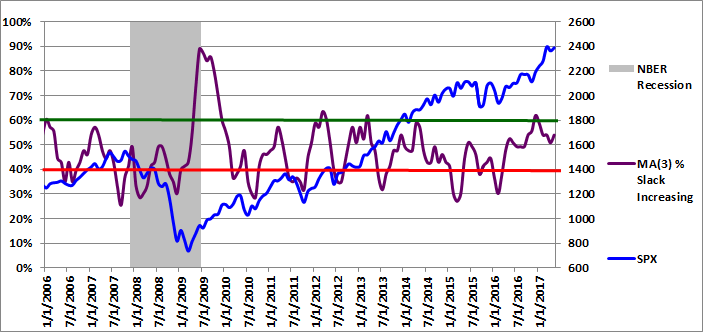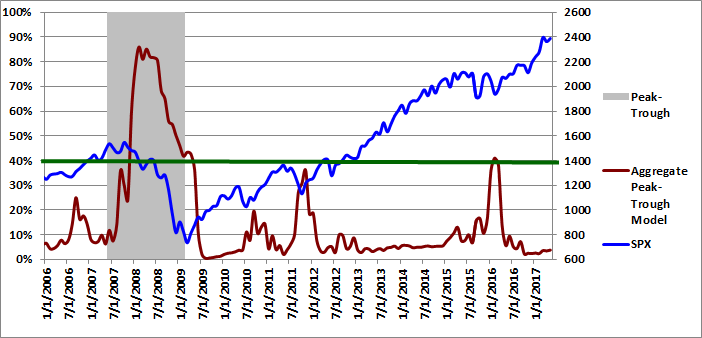The following article updates the diffusion index, recession slack index, aggregate recession model, and aggregate peak-trough model through April 2017. The current 21-variable model has a diverse set of explanatory variables and is quite robust. Each of the explanatory variables has predictive power individually; when combined, the group of indicators is able to identify early recession warnings from a wide range of diverse market-based, fundamental, technical, and economic sources.
Several of the explanatory variables are market-based. These variables respond very quickly to changing market conditions and are never revised. This makes the Trader Edge recession model much more responsive than other recession models. The current and historical data in this report reflect the current model configuration with all 21 variables.
Diffusion Index
The Trader Edge diffusion index equals the percentage of independent variables indicating a recession. With the recent changes, there are now a total of 21 explanatory variables, each with a unique look-back period and recession threshold. The resulting diffusion index and changes in the diffusion index are used to calculate the probit, logit, and neural network model forecasts.
The graph of the diffusion index from 1/1/2006 to 5/1/2017 is presented in Figure 1 below (in red - left axis). The gray shaded regions in Figure 1 below represent U.S. recessions as defined (after the fact) by the National Bureau of Economic Research (NBER). The value of the S&P 500 index is also included (in blue - right axis).
The U.S. economy flirted with entering a recession in early 2016, which was reflected in the deteriorating economic, fundamental, and especially market-based data. The diffusion index, slack index, and recession probability forecasts all captured the weakening conditions. However, the weakness proved to be temporary and the conditions and recession model forecasts have improved significantly in the past year. The number of variables indicating a recession is currently one out of 21 (4.76%), which increased from zero out of 21 last month. The diffusion index only remained at zero for a single month.
Please note that past estimates and index values will change whenever the historical data is revised. All current and past forecasts and index calculations are based on the latest revised data from the current data set.

Figure 1: Diffusion Index 05-01-2017
Recession Slack Index
The Trader Edge recession slack index equals the median standardized deviation of the current value of the explanatory variables from their respective recession thresholds. The resulting value signifies the amount of slack or cushion relative to the recession threshold, expressed in terms of the number of standard deviations. Higher slack values signify larger cushions above recessionary threshold levels.
The gray shaded regions in Figure 2 below represent U.S. recessions as defined (after the fact) by the NBER. The median recession slack index is depicted in purple and is plotted against the right axis, which is expressed as the number of standard deviations above the recession threshold.
The dark-red, horizontal line at 0.50 standard deviations denotes a possible warning threshold for the recession slack index. Many of the past recessions began when the recession slack index crossed below 0.50. Similarly, many of the past recessions ended when the recession slack index crossed back above 0.0.
In mid-2014, the revised median recession slack index peaked at 1.16, far above the warning level of 0.50. The recession slack index declined significantly in 2015 and reached a low 0.32 in February 2016, before rebounding over the next few months.
The recession slack index is currently 1.19, which is up sharply from last month's value of 0.97. With the exception of last month, the slack index has been robust for the past six months. The slack index is significantly above the early warning threshold.

Figure 2: Median Recession Slack Index 05-01-2017
To gain further insight into the slack index, I recently went back and calculated a derivative value: the percentage of variables with increasing slack each month. The possible values range from zero percent to 100 percent. Due to the monthly volatility, I provide the three-month moving average of the percentage of variables with increasing slack in Figure 3, but I personally monitor the monthly percentages as well.
Slack is a standardized value, so it is directly comparable across all variables. More slack indicates a larger cushion relative to a recessionary environment. As a result, we would like to see as many variables as possible with increasing slack. Given the diverse nature of the explanatory variables, it is unusual to see more than 60% of the variables with increasing slack or fewer than 40% of the variables with increasing slack. These extreme values are significant and predictive of the near-term direction of economic growth and often the equity market.
The most recent moving average percentage is 54.0%, which increased from last month's average of 50.8%. Despite the increase in the diffusion index from zero to one in April, the more continuous slack data suggests the robustness of the economy strengthened last month.

Figure 3: MA(3) % Slack Increasing 05-01-2017
The ability to track small variations and trend changes over time illustrates the advantage of monitoring the continuous recession slack index. The new slack variable will provide additional insight into the near-term direction of the economy and should be used in conjunction with the median recession slack index.
While it is useful to track the actual recession slack index values and percentage of variables with increasing slack, the diffusion percentages and slack index values are also used to generate the more intuitive probit and logit probability forecasts.
Aggregate Recession Probability Estimate
The Trader Edge aggregate recession model is the average of four models: the probit and logit models based on the diffusion index and the probit and logit models based on the recession slack index. The aggregate recession model estimates from 1/1/2006 to 5/01/2017 are depicted in Figure 4 below (red line - left vertical axis). The gray shaded regions represent NBER recessions and the blue line reflects the value of the S&P 500 index (right vertical axis). I suggest using a warning threshold of between 20-30% for the aggregate recession model (green horizontal line).
The aggregate recession model probability estimate increased from 0.0% to 0.1% in April 2017. According to the model, the probability that the U.S. is currently in a recession continues to be extremely remote.

Figure 4: Aggregate Recession Model 05-01-2017
Aggregate Peak-Trough Probability Estimate
The peak-trough model forecasts are different from the recession model. The peak-trough models estimate the probability of the S&P 500 being between the peak and trough associated with an NBER recession. The S&P 500 typically peaks before recessions begin and bottoms out before recessions end. As a result, it is far more difficult for the peak-trough model to fit this data and the model forecasts have larger errors than the recession model.
The Trader Edge aggregate peak-trough model equals the weighted-average of nine different models: the probit and logit models based on the diffusion index, the probit and logit models based on the recession slack index, and five neural network models.
The aggregate peak-trough model estimates from 1/1/2006 to 5/01/2017 are depicted in Figure 5 below, which uses the same format as Figure 4, except that the shaded regions represent the periods between the peaks and troughs associated with NBER recessions.
The aggregate peak-trough model probability estimate for 5/01/2017 was 3.8%, which was up slightly from last month's revised value of 3.5%.

Figure 5: Aggregate Peak-Trough Model 05-01-2017
Conclusion
January and February 2016 marked a potential tipping point in U.S. recession risk, but those conditions proved to be temporary. Conditions have improved significantly since early 2016. The decrease in recession risk has been supported by both market and non-market variables.
Despite the one month increase in the diffusion index, U.S. recession risk remains very low. However, recessions are not the only source of pullbacks in the equity markets. The U.S. equity market continues to be overvalued and global event risk continues to be elevated.
Unlike human prognosticators, the Trader Edge recession model is completely objective and has no ego. It is not burdened by the emotional need to defend past erroneous forecasts and will always consistently apply the insights gained from new data.
Brian Johnson
Copyright 2017 Trading Insights, LLC. All rights reserved.
Option Strategy Risk Management: An In-Depth Article Introducing an Interactive Analytical Framework for Hedging Option Strategy Risk
Option Income Strategy Trade Filters: An In-Depth Article Demonstrating the Use of Trade Filters to Enhance Returns and Reduce Risk
Exploiting Earnings Volatility: An Innovative New Approach to Evaluating, Optimizing, and Trading Option Strategies to Profit from Earnings Announcements.
Option Strategy Risk / Return Ratios: A Revolutionary New Approach to Optimizing, Adjusting, and Trading Any Option Income Strategy












Recession Model Forecast: 05-01-2017
The following article updates the diffusion index, recession slack index, aggregate recession model, and aggregate peak-trough model through April 2017. The current 21-variable model has a diverse set of explanatory variables and is quite robust. Each of the explanatory variables has predictive power individually; when combined, the group of indicators is able to identify early recession warnings from a wide range of diverse market-based, fundamental, technical, and economic sources.
Several of the explanatory variables are market-based. These variables respond very quickly to changing market conditions and are never revised. This makes the Trader Edge recession model much more responsive than other recession models. The current and historical data in this report reflect the current model configuration with all 21 variables.
Diffusion Index
The Trader Edge diffusion index equals the percentage of independent variables indicating a recession. With the recent changes, there are now a total of 21 explanatory variables, each with a unique look-back period and recession threshold. The resulting diffusion index and changes in the diffusion index are used to calculate the probit, logit, and neural network model forecasts.
The graph of the diffusion index from 1/1/2006 to 5/1/2017 is presented in Figure 1 below (in red - left axis). The gray shaded regions in Figure 1 below represent U.S. recessions as defined (after the fact) by the National Bureau of Economic Research (NBER). The value of the S&P 500 index is also included (in blue - right axis).
The U.S. economy flirted with entering a recession in early 2016, which was reflected in the deteriorating economic, fundamental, and especially market-based data. The diffusion index, slack index, and recession probability forecasts all captured the weakening conditions. However, the weakness proved to be temporary and the conditions and recession model forecasts have improved significantly in the past year. The number of variables indicating a recession is currently one out of 21 (4.76%), which increased from zero out of 21 last month. The diffusion index only remained at zero for a single month.
Please note that past estimates and index values will change whenever the historical data is revised. All current and past forecasts and index calculations are based on the latest revised data from the current data set.
Figure 1: Diffusion Index 05-01-2017
Recession Slack Index
The Trader Edge recession slack index equals the median standardized deviation of the current value of the explanatory variables from their respective recession thresholds. The resulting value signifies the amount of slack or cushion relative to the recession threshold, expressed in terms of the number of standard deviations. Higher slack values signify larger cushions above recessionary threshold levels.
The gray shaded regions in Figure 2 below represent U.S. recessions as defined (after the fact) by the NBER. The median recession slack index is depicted in purple and is plotted against the right axis, which is expressed as the number of standard deviations above the recession threshold.
The dark-red, horizontal line at 0.50 standard deviations denotes a possible warning threshold for the recession slack index. Many of the past recessions began when the recession slack index crossed below 0.50. Similarly, many of the past recessions ended when the recession slack index crossed back above 0.0.
In mid-2014, the revised median recession slack index peaked at 1.16, far above the warning level of 0.50. The recession slack index declined significantly in 2015 and reached a low 0.32 in February 2016, before rebounding over the next few months.
The recession slack index is currently 1.19, which is up sharply from last month's value of 0.97. With the exception of last month, the slack index has been robust for the past six months. The slack index is significantly above the early warning threshold.
Figure 2: Median Recession Slack Index 05-01-2017
To gain further insight into the slack index, I recently went back and calculated a derivative value: the percentage of variables with increasing slack each month. The possible values range from zero percent to 100 percent. Due to the monthly volatility, I provide the three-month moving average of the percentage of variables with increasing slack in Figure 3, but I personally monitor the monthly percentages as well.
Slack is a standardized value, so it is directly comparable across all variables. More slack indicates a larger cushion relative to a recessionary environment. As a result, we would like to see as many variables as possible with increasing slack. Given the diverse nature of the explanatory variables, it is unusual to see more than 60% of the variables with increasing slack or fewer than 40% of the variables with increasing slack. These extreme values are significant and predictive of the near-term direction of economic growth and often the equity market.
The most recent moving average percentage is 54.0%, which increased from last month's average of 50.8%. Despite the increase in the diffusion index from zero to one in April, the more continuous slack data suggests the robustness of the economy strengthened last month.
Figure 3: MA(3) % Slack Increasing 05-01-2017
The ability to track small variations and trend changes over time illustrates the advantage of monitoring the continuous recession slack index. The new slack variable will provide additional insight into the near-term direction of the economy and should be used in conjunction with the median recession slack index.
While it is useful to track the actual recession slack index values and percentage of variables with increasing slack, the diffusion percentages and slack index values are also used to generate the more intuitive probit and logit probability forecasts.
Aggregate Recession Probability Estimate
The Trader Edge aggregate recession model is the average of four models: the probit and logit models based on the diffusion index and the probit and logit models based on the recession slack index. The aggregate recession model estimates from 1/1/2006 to 5/01/2017 are depicted in Figure 4 below (red line - left vertical axis). The gray shaded regions represent NBER recessions and the blue line reflects the value of the S&P 500 index (right vertical axis). I suggest using a warning threshold of between 20-30% for the aggregate recession model (green horizontal line).
The aggregate recession model probability estimate increased from 0.0% to 0.1% in April 2017. According to the model, the probability that the U.S. is currently in a recession continues to be extremely remote.
Figure 4: Aggregate Recession Model 05-01-2017
Aggregate Peak-Trough Probability Estimate
The peak-trough model forecasts are different from the recession model. The peak-trough models estimate the probability of the S&P 500 being between the peak and trough associated with an NBER recession. The S&P 500 typically peaks before recessions begin and bottoms out before recessions end. As a result, it is far more difficult for the peak-trough model to fit this data and the model forecasts have larger errors than the recession model.
The Trader Edge aggregate peak-trough model equals the weighted-average of nine different models: the probit and logit models based on the diffusion index, the probit and logit models based on the recession slack index, and five neural network models.
The aggregate peak-trough model estimates from 1/1/2006 to 5/01/2017 are depicted in Figure 5 below, which uses the same format as Figure 4, except that the shaded regions represent the periods between the peaks and troughs associated with NBER recessions.
The aggregate peak-trough model probability estimate for 5/01/2017 was 3.8%, which was up slightly from last month's revised value of 3.5%.
Figure 5: Aggregate Peak-Trough Model 05-01-2017
Conclusion
January and February 2016 marked a potential tipping point in U.S. recession risk, but those conditions proved to be temporary. Conditions have improved significantly since early 2016. The decrease in recession risk has been supported by both market and non-market variables.
Despite the one month increase in the diffusion index, U.S. recession risk remains very low. However, recessions are not the only source of pullbacks in the equity markets. The U.S. equity market continues to be overvalued and global event risk continues to be elevated.
Unlike human prognosticators, the Trader Edge recession model is completely objective and has no ego. It is not burdened by the emotional need to defend past erroneous forecasts and will always consistently apply the insights gained from new data.
Brian Johnson
Copyright 2017 Trading Insights, LLC. All rights reserved.
Option Strategy Risk Management: An In-Depth Article Introducing an Interactive Analytical Framework for Hedging Option Strategy Risk
Option Income Strategy Trade Filters: An In-Depth Article Demonstrating the Use of Trade Filters to Enhance Returns and Reduce Risk
Exploiting Earnings Volatility: An Innovative New Approach to Evaluating, Optimizing, and Trading Option Strategies to Profit from Earnings Announcements.
Option Strategy Risk / Return Ratios: A Revolutionary New Approach to Optimizing, Adjusting, and Trading Any Option Income Strategy
About Brian Johnson
I have been an investment professional for over 30 years. I worked as a fixed income portfolio manager, personally managing over $13 billion in assets for institutional clients. I was also the President of a financial consulting and software development firm, developing artificial intelligence based forecasting and risk management systems for institutional investment managers. I am now a full-time proprietary trader in options, futures, stocks, and ETFs using both algorithmic and discretionary trading strategies. In addition to my professional investment experience, I designed and taught courses in financial derivatives for both MBA and undergraduate business programs on a part-time basis for a number of years. I have also written four books on options and derivative strategies.